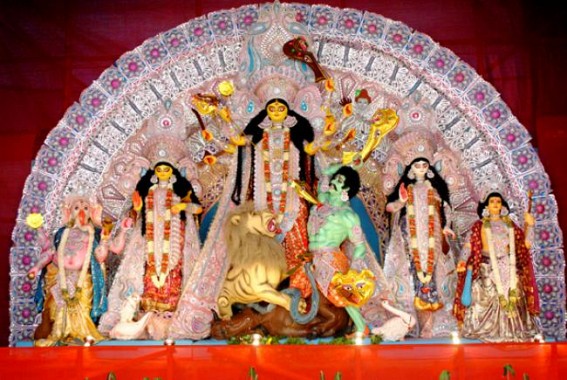TIWN

Agartala, October 1 (TIWN): Pomp and pageantry marked Maha Saptami - day two of the Durga Puja - as thousands of revellers decked up in their best hit the streets of the capital Agartala and other important towns - Udaipur, Dharmanagar, Kailashahar, Belonia, Amarpur etc on wednesday.
The usual five-day autumn carnival, shortened to a four-day affair this time according to the almanac, is the biggest annual event in this part of the world when even the newspapers shut down and roads are choked with human traffic throughout the day and night.
Since early morning, people have been thronging colossal puja pandals (marquees) where idols of the goddess and her four children are being worshipped amid much community fanfare.
People danced, whistled, mingled with friends and family in an infectious all-embracing spirit.
Durga Puja is being celebrated at 2335 places in Tripura including 1023 pujas in urban and 1312 pujas in rural areas. In the city near more than five hundred puja pandals had been decorated. Among them in West district the number exists to 723, khowai-280, Gomati-265, South-251, Sepahijala-200, Unakoti-160, Dhalai-229, North-195.
Like previous years elaborate police arrangements have been made in the state to ensure peaceful celebration of the festival. More than 3 thousand police personnel and two thousand TSR have been deployed. 22 police assistance booths and 18 drop gates are also keeping in alert. Other than that 18 watch towers around city and shopping malls. Hospitals and other crowded places, CCTV cameras are installed. In case of railway passengers, TSR are engaged in every compartment. Highway patrolling team will also keep an alert.
The religious rituals of Maha Saptami (seventh day on the lunar calendar) began with the bathing of a banana plant in ponds. The plant is treated like a bride, wrapped in a new sari and placed next to the idol of Lord Ganesh, son of Goddess Durga. This plant is called Kalabau' (banana plant bride) - considered the wife of Ganesha.
The ritual is called 'Nabapatrika snan-o-sthapan' and many believe this practise is traced to the agrarian society of east India.
The Nabapatrika (new leaves) consists of nine banana leaves. After the ritual, special worship for Saptami started and devotees on an empty stomach thronged pandals to pray to Durga and offered her 'pushpanjali' (floral offerings to the goddess).
According to Hindu mythology, the festivities and prayers begin with the symbolic arrival of the goddess on earth on the sixth day of the first quarter of the moon and ends on Dashami or the 10th day, which is celebrated across the country as Dussehra.
Traditionally, every pandal has an idol of Goddess Durga depicting her as slaying the demon Mahishasur. She is shown astride a lion and wielding an array of weapons in her 10 arms.
- Two Suspected Thieves Were Arrested in Udaipur’s Kakraban
- CT Scan Machine Remains Unfunctional at GB Hospital Trauma Center
- SPO and her Husband Booked in Tripura for Job Scams
- Ranji Trophy's 2019-20 Best All-Rounder Player Manishankar Murasingh Appointed as TTAADC Brand Ambassador
- Tripura Govt ‘Discussing’ Over High Court’s Recent Verdict Against Fixed Pay System: CM cites ‘Limited Resources’



